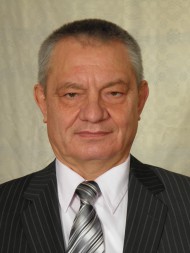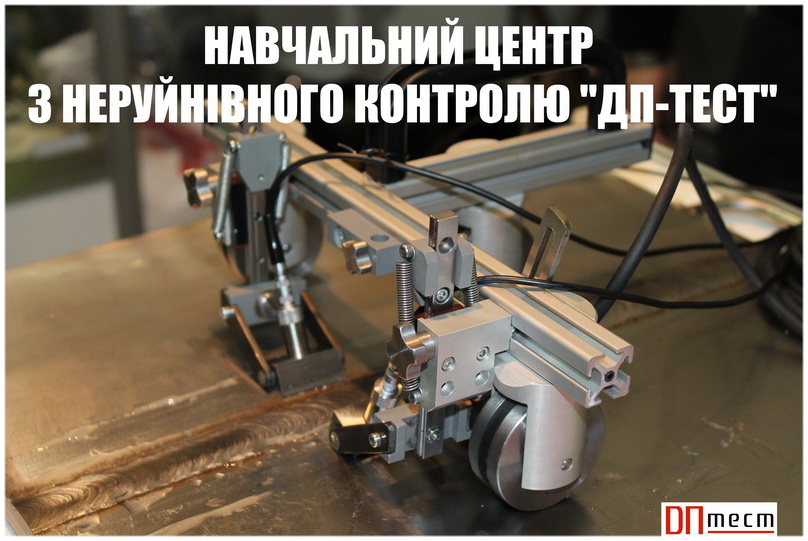 В 1976 році закінчив Київський політехнічний інститут (КПІ), кафедра інформаційно-вимірювальної техніки факультету автоматики та електроприладобудування. Спеціальність – інженер-електрик.
В 1976 році закінчив Київський політехнічний інститут (КПІ), кафедра інформаційно-вимірювальної техніки факультету автоматики та електроприладобудування. Спеціальність – інженер-електрик.
В 1983 році закінчив аспірантуру КПІ, а в1984 році успішно захистив кандидатську дисертацію на тему «Волоконно-оптичні багатомодові фазові первинні вимірювальні перетворювачі».
В 1988 році присвоєно вчене звання доцента по кафедрі приладів та систем неруйнівного контролю.
В КПІ з 1970 року – студент, інженер, молодший науковий співробітник, аспірант, старший науковий співробітник, асистент, доцент. З 2021 року працює на кафедрі автоматизації та систем неруйнівного контролю (АСНК) на посаді доцента та відповідальний за організацію виробничих, переддипломних та науково-дослідних практик студентів.
Наукові інтереси: оптимізація інформаційно-вимірювальних систем, застосування передових мережевих технологій в приладобудуванні, вимірювальні засоби в системах неруйнівного контролю.
Сторінка викладача в системі "Інтелект"
НАУКОВІ ПРАЦІ:
Using The Pulsed Eddy Current Techniques For Monitoring The Aircraft Structure Condition
It is known that during operation, the aircraft construction materials are exposed to significant mechanical loads and changes in temperature for a very short period of time. All this leads to various defects and damages in the aircraft assemblies and units that need to be inspected for the safe operation of the aircraft, their assemblies, and units. In some cases, the implementation of inspection or diagnostic is accompanied by the emergence of technical difficulties caused by the large size of the aircraft assemblies or units and limited access to their local places. Under such conditions, ensuring the possibility of diagnosis in hard-to-reach places of the object becomes especially important. the problem can be solved by applying wireless technologies. It allows spatial separation of the probes and the signal processing units, which simplifies the scanning of the surfaces of the large assemblies and units in hard-to-reach places. In this article, the description of the developed wireless system of eddy current inspection for aircraft structural materials is given. experimental results of object scanning are given in the form of a distribution of the values of probe signal informative parameters (amplitude, frequency and decrement) along the object coordinates.
--/ I. Lysenko, Y. Kuts, V. Uchanin, A. Protasov, V. Petryk, A. Alexiev // Transactions on Aerospace Research. - Institute of Aviation : Poland, 2023. - Vol. 1 (270). - P. 22-31.
Intelligent Automated Eddy Current System for Monitoring the Aircraft Structure Condition
It is known that in the process of operation the materials of aircraft construction are exposed to significant mechanical loads and temperature changes (fluctuations) for a very short period of time. All this leads to various defects and damages to aircraft assemblies and units which need to be inspected for the safe operation of the aircraft, their assemblies, and units. In some cases, the implementation of inspection or diagnostic is accompanied by technical difficulties caused by the large size of-aircraft assemblies or units and limited access to their local places. In such conditions, it becomes especially important to provide the possibility of diagnostics in hard-to-reach places of the object.The problem can be solved by applying wireless technologies to transmit signals from the probes to the data processing units. This allows separating the probes unit and the analysis and decision-making unit in space, and simplifies the practical implementation of robotics scanning the surfaces of large assemblies and elements in hard-to-reach places.The article describes the developed intelligent wireless system for eddy current inspection of aircraft structural materials. A technique for processing and visualization information is proposed that can be used in inspection systems and intelligent decision-making when monitoring the state of large objects. The experimental results of scanning an object are presented as a distribution of the informative parameters values of the probing signal (amplitude, frequency and decrement) over the coordinates of the object.
--/ I. Lysenko, V. Uchanin, V. Petryk, Y. Kuts, A. Protasov, A. Alexiev // 2022 IEEE 3rd International Conference on System Analysis & Intelligent Computing (SAIC). - 2022. - P. 1-5.
Automated Eddy Current System for Express Monitoring
In operation, the materials of machine and aircraft elements are exposed to significant mechanical loads and temperature changes. It leads to various defects and damage to elements, components of mechanisms, and devices. So for the safe operation of mechanisms and devices, it is necessary to inspect their elements, and then carry out the necessary work on their replacement in time. In some cases, the inspection or diagnostics of the elements is accompanied by technical difficulties caused by the large size of the objects and limited access to local places. The author of the article suggests using wireless technologies to transmit signals from the probe unit to the data processing one. It allows the separation of the measurement unit and data analysis unit in space and also it simplifies the practical implementation of robotic systems for scanning objects or their elements in hard-to-reach places. The article describes the developed intelligent wireless system of eddy current control of structural materials. Also, the method of information processing and visualization is described. The method can be used to automate decision-making in the system of monitoring the condition of large objects. Special software (using Python) has been developed to process the object scanning results. It allows obtaining the distribution of the values of the signal informative parameters depending on the coordinates of the object.
--/ Y. Kuts, I. Lysenko, A. Protasov, V. Petryk, A. Alexiev // International Journal “NDT Days”. – BSNDT : Bulgaria, 2022. ‒ Volume 5, Issue 5. ‒ P. 269-276.
Практика: організація, підготовка, проведення [Електронний ресурс] : навчальний посібник для здобувачів ступеня магістр за освітньою програмою «Комп'ютерно-інтегровані системи та технології в приладобудуванні» спеціальності 151 «Автоматизація та комп’ютерно-інтегровані технології» / КПІ ім. Ігоря Сікорського ; уклад.: Г. А. Богдан, В. Ф. Петрик, Н. І. Бурау. – Електронні текстові дані (1 файл: 0,38 Мбайт). – Київ : КПІ ім. Ігоря Сікорського, 2022. – 46 с.
Smartphone-based automated non-destructive testing devices
Currently, non-destructive testing is an interdisciplinary field of science and technology that serves to ensure the safe functioning of complex technical systems in the face of multifactorial risks. In this regard, there is a need to consider new information technologies based on intellectual perception, recognition technology, and general network integration. The purpose of this work was to develop an ultrasonic flaw detector, which uses a smartphone to process the test results, as well as transfer them directly to an powerful information processing center, or to a cloud storage to share operational information with specialists from anywhere in the world.The proposed flaw detector consists of a sensor unit and a smartphone. The exchange of information between the sensor and the smartphone takes place using wireless networks that use "bluetooth" technology. To ensure the operation of the smartphone in the ultrasonic flaw detector mode, the smartphone has software installed that runs in the Android operating system and implements the proposed algorithm of the device, and can serve as a repeater for processing data over a considerable distance (up to hundreds and thousands of kilometers) if it necessary.The experimental data comparative analysis of the developed device with the Einstein-II flaw detector from Modsonic (India) and the TS-2028H+ flaw detector from Tru-Test (New Zealand) showed that the proposed device is not inferior to them in terms of such characteristics as the range of measured thicknesses, the relative error in determining the depth defect and the object thickness. When measuring small thicknesses from 5 to 10 mm, the proposed device even surpasses them, providing a relative measurement error of the order of 1 %, while analogues give this error within 2-3 %.
-- / Petryk V. F., Protasov A. G., Galagan R. M., Muraviov A. V., Lysenko I. I. // Приборы и методы измерений. 2020. №4.
Використання серійних мобільних пристроїв при проектуванні портативних дефектоскопів
Стаття присвячена проблемі застосування бездротової передачі даних у сучасних дефектоскопах, використовуваних для неруйнівного контролю різних об’єктів. Бездротове з’єднання між вимірювальними датчиками й процесором підвищує надійність тестування й скорочує час ухвалення рішення. Це підвищує стійкість обладнань у несприятливих умовах навколишнього середовища й дає змогу спростити виконання операцій у будь-якому положенні. Стаття містить у собі результати роботи з об’єднання завдань бездротової передачі даних від сенсора до блока обробки інформації у вигляді смартфона та з потреби передачі її за допомогою технології GSM на велику відстань до центру обробки інформації, який оснащений потужним комп’ютерним обладнанням. Висококваліфіковані спеціалісти, використовуючи найсучасніше програмне забезпечення, обробляють у центрі одержані дані. Розглянуто структурну схему пристрою, схему електричну принципову імпульсного збуджувача акустичних коливань з електричним демпфуванням. Наведені експериментальні результати виконаної роботи у вигляді порівняльного аналізу отриманих діагностичних даних розробленого приладу і його найближчого аналогу за технічними параметрами та ціною (прилад Einstein-II).
--/ Петрик В. Ф., Протасов А. Г., Сєрий К. М., Повшенко О. А. // Вчені записки ТНУ імені В.І. Вернадського. Серія: Технічні науки. – 2019. – Т. 30 (69), № 6, ч. 2. – C. 12–16. – Бібліогр.: 9 назв.
Using Wireless Data Transmission In Eddy Current Nondestructive Testing
--// Сб. материалов 10-й международной научно-технической конференции «ПРИБОРОСТРОЕНИЕ – 2017». – Минск, Республика Беларусь, 2017. – C. 74-76
Мобильный вихретоковый дефектоскоп с беспроводной системой передачи данных
This article has described the direction in the development of the modern flaw detection - wireless connection. Wireless connectivity between the measuring sensors and processing unit increases the reliability of testing and decreases the decision-making time. It increases stability of devices under adverse environmental conditions and allows for simplifying executing operation in any position. The article includes the descriptions of the advantages of the GSM channel and justification of existing standards for particular non-destructive testing tasks and conditions.
--// Ж-л «Научные известия на НТС машиностроения», Созополь, Болгария. – 2016 – №187. – С. 43–45.
ВИКОРИСТАННЯБЕЗПРОВІДНИХ ТЕХНОЛОГІЙ ПЕРЕДАЧІ ДАНИХ ДЛЯ ВИРІШЕННЯ ЗАДАЧ У НЕРУЙНІВНОМУ КОНТРОЛІ
Розглянуто новий напрямок у використанні бездротових засобів передачі даних для технічної діагностики з відомими способами неруйнівного контролю. Виконано огляд можливостей застосування різних бездротових засобів передачі даних та обгрунтування використання існуючих стандартів для певних задач і умов неруйнівного контролю. Наведено узагальнену функціональну схему системи (приладу) з використанням безпровідного каналу передачі даних.
--// Вісник Національного технічного університету "Харківський політехнічний інститут" . Збірник наукових праць. Тематичний випуск: Електроенергетика та перетворювальна техніка. – Харків: НТУ "ХПІ". – 2012. – № 40. – 141 с.









